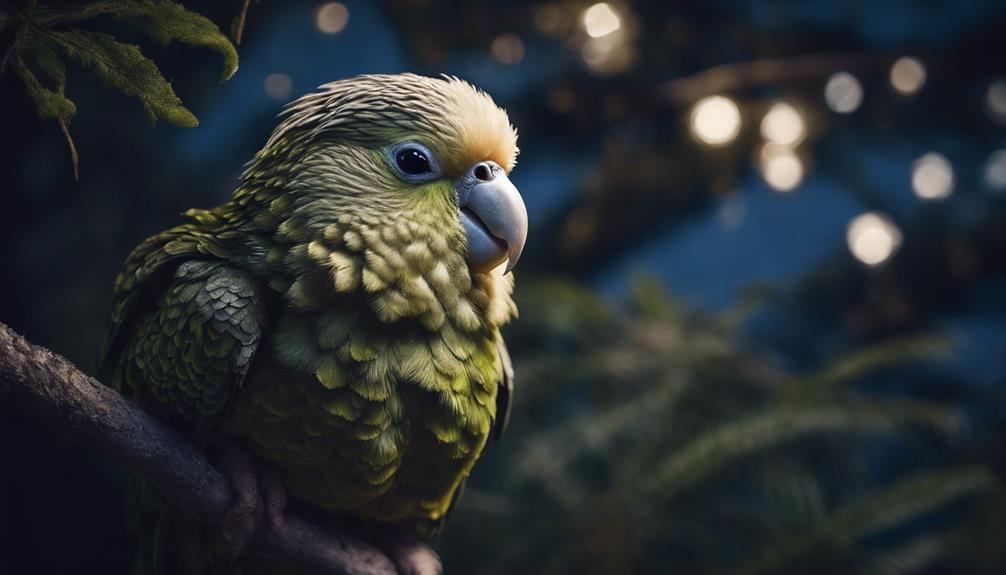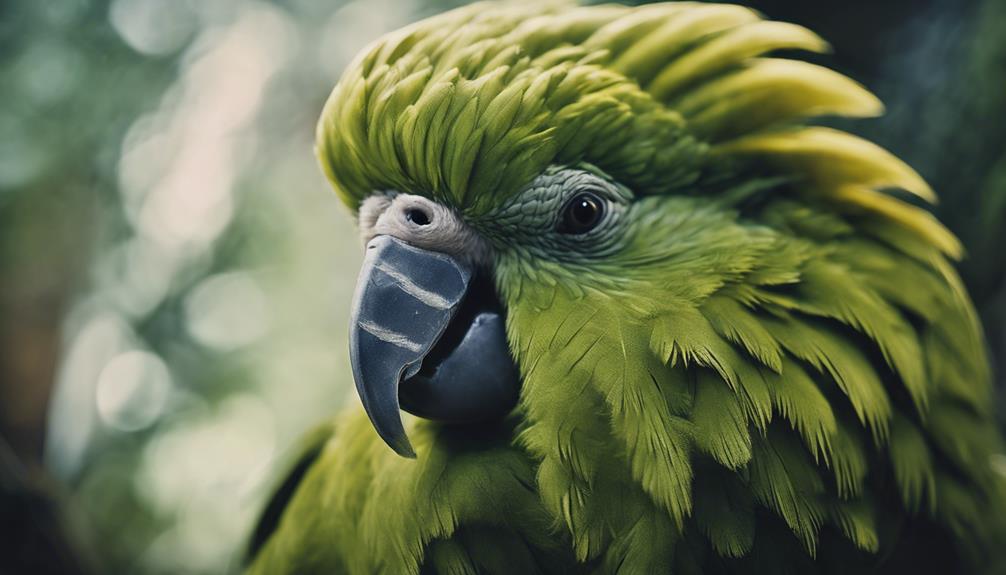Why Kakapo Parrots Are Unique in the Parrot Family

Kakapo parrots are unique in the parrot family due to their nocturnal lifestyle, flightless adaptations, intricate mating rituals, and unique vocal communication.
This combination of characteristics makes them a fascinating species to study.
Evolutionary Background
The evolutionary history of the unique Kakapo parrots traces back through millennia, showcasing remarkable adaptations to their island habitat. Kakapos, also known as night parrots, have a fascinating genetic diversity that has played a crucial role in their survival on remote islands like New Zealand. These flightless, nocturnal parrots have evolved over time to fit their specific ecological niche, resulting in distinct characteristics that set them apart from other parrot species.
Studying the evolutionary history of Kakapos provides valuable insights into how these birds have adapted to their environment over thousands of years. Through genetic analyses, scientists have uncovered the intricate relationships between different Kakapo populations and their ancestors, shedding light on the factors that have shaped their genetic diversity. Understanding the genetic makeup of Kakapos is essential for conservation efforts, as it helps researchers develop strategies to preserve the unique traits that make these parrots so special.
Nocturnal Lifestyle

Kakapo parrots exhibit unique sleep patterns that are characterized by their nocturnal lifestyle, with most of their activities occurring during the night.
To adapt to the darkness, these birds have evolved specialized sensory mechanisms, such as keen night vision and acute hearing, allowing them to navigate their surroundings with precision.
This nocturnal behavior not only helps kakapos avoid predators but also enables them to efficiently forage for food in the cover of darkness.
Unique Sleep Patterns
Exhibiting a nocturnal lifestyle, Kakapo parrots showcase unique sleep patterns that align with their natural habitat and behaviors. These parrots have evolved to adapt to a lifestyle where they are most active during the night, taking advantage of the darkness to forage for food and avoid predators. Their sleeping habits are intricately tied to their circadian rhythms, which are synchronized with the night and day cycles of their environment. Kakapos exhibit a fascinating behavior of forming "trackways" on their home islands, indicating their preferred routes for movement during the night. This behavior shows their ability to navigate efficiently in the darkness, further highlighting their unique adaptations for a nocturnal lifestyle.
| Sleep Patterns | Observations | Significance |
|---|---|---|
| Daytime Rest | Limited activity during the day | Preserving energy for night activity |
| Nighttime Sleep | Active foraging and movement | Enhanced nocturnal survival skills |
| Trackway Formation | Consistent pathways used at night | Efficient navigation in darkness |
Adaptations for Darkness
Adapted to the darkness of their environment, Kakapo parrots demonstrate specialized physiological and behavioral traits that optimize their survival during nocturnal activities.
To blend with their surroundings, Kakapos exhibit remarkable camouflage strategies, such as their mossy green feathers with black speckles that help them disappear into the forest floor.
These parrots also undergo behavioral changes, becoming more active at night, relying on their keen sense of smell and ability to navigate in low-light conditions.
By minimizing movement and vocalizations during nighttime, Kakapos reduce the risk of attracting predators.
These adaptations enable Kakapos to thrive in their nocturnal lifestyle, showcasing their remarkable ability to adjust to the challenges of their unique environment.
Flightless Adaptations

Kakapo parrots showcase remarkable adaptations to their flightless lifestyle. Their wings have undergone significant reduction, rendering them incapable of sustained flight but aiding in balance and agility on the ground.
In place of flight, these birds have evolved powerful legs that enable them to climb trees and navigate the rugged terrain of their island habitats.
Wing Reduction for Ground
With their uniquely adapted bodies, Kakapo parrots showcase remarkable wing reduction for ground-based living, a feature essential to their flightless lifestyle. This adaptation has evolved over time to suit their specific ecological niche.
- Shortened Wings: The Kakapo's wings are significantly reduced in size compared to other parrot species, making them inefficient for flight but well-suited for balance and stability on the ground.
- Muscular Development: Despite their reduced wings, Kakapos have strong wing muscles, allowing them to support their body weight and maneuver effectively in their terrestrial habitat.
- Clawed Feet: To compensate for the lack of flight, Kakapos have developed robust, clawed feet that aid in climbing and navigating rugged terrain with ease.
Strong Legs for Climbing
The Kakapo parrot's robust leg muscles are crucial for their adept climbing abilities in their flightless lifestyle. These parrots, with their tree-dwelling habits, rely heavily on their strong legs to navigate the rugged terrains of their native forests.
Their muscular legs provide them with the power and stability needed to climb steep inclines, grasp onto branches, and move with agility through the dense vegetation. Kakapos exhibit remarkable climbing abilities, using their legs to push off the ground and propel themselves upwards, showcasing their adaptability to a life without flight.
Through their well-developed leg muscles, Kakapo parrots have evolved specialized skills that enable them to thrive in their unique arboreal environment.
Adapted for Island
Adapted for island life, these flightless Kakapo parrots have developed unique physical and behavioral traits that enhance their survival in their isolated habitat.
- Island Adaptations:
- Kakapos have evolved to be flightless, as there are no natural predators on the isolated islands they inhabit.
- Unique Behaviors:
- These parrots are nocturnal, which helps them avoid diurnal predators and efficiently forage for food in the dark.
- Specialized Anatomy:
- Kakapos have strong legs for climbing trees and rugged terrains, aiding in their movement across the diverse landscapes of their island homes.
These island adaptations and unique behaviors collectively contribute to the Kakapo parrots' successful existence in their specialized island environment.
Mating Rituals

During the mating season, male Kakapo parrots perform elaborate courtship displays to attract females. These courtship behaviors play a crucial role in the breeding success and reproductive outcomes of these unique parrots. The Kakapo mating displays are fascinating to observe, showcasing the male's efforts to impress potential mates.
| Courtship Behavior | Breeding Success |
|---|---|
| Displaying vibrant colors and patterns | Attracts females for mating |
| Performing intricate dances and movements | Demonstrates health and vitality |
| Emitting deep booming calls | Signals readiness for reproduction |
Male Kakapos exhibit a range of courtship behaviors to maximize their reproductive success. By displaying their vibrant plumage, engaging in intricate dances, and emitting resonant calls, they communicate their suitability as mates to female Kakapos. These elaborate mating rituals highlight the importance of courtship displays in the breeding success of Kakapo parrots.
Vocal Communication

Male Kakapo parrots utilize a diverse range of vocalizations to communicate with potential mates and establish social bonds within their unique community. These vocalizations play a crucial role in their social interactions and are key to their survival.
Here are some key aspects of their vocal communication:
- Vocal Mimicry: Kakapo parrots are known for their exceptional ability to mimic sounds from their environment. This skill allows them to adapt to various situations and communicate with other members of their species effectively. Through vocal mimicry, they can attract potential mates by imitating specific calls or sounds that signify readiness for mating.
- Social Interactions: Vocal communication is vital for Kakapo parrots to navigate their complex social structure. They use different calls and vocalizations to establish hierarchies, convey emotions such as distress or happiness, and maintain connections within their community. These interactions help strengthen bonds among individuals and foster cooperation essential for their survival in the wild.
- Unique Vocal Repertoire: Each Kakapo parrot has a distinct vocal repertoire, including a combination of whistles, booms, and chatters. This diversity in vocalizations allows them to express a wide range of emotions and messages, enhancing their ability to communicate effectively in various contexts.
Endangered Status

Endangered due to habitat loss and predation, the Kakapo parrot faces a critical threat to its survival in the wild. Conservation challenges have contributed to a significant population decline, with only around 200 Kakapo parrots remaining today. Habitat destruction, mainly caused by deforestation and the introduction of invasive species, has severely impacted the Kakapo's natural environment. The loss of suitable nesting sites and food sources has further exacerbated their vulnerable status. Poaching threats also pose a significant risk to the Kakapo population, as their unique traits make them desirable in the illegal wildlife trade.
The decline in Kakapo numbers highlights the urgent need for conservation efforts to protect this endangered species. Without intervention, the Kakapo parrot faces the risk of extinction. Awareness of the conservation challenges facing the Kakapo is essential for developing effective strategies to safeguard their future in the wild. By addressing the issues of habitat destruction and poaching threats, there's hope to reverse the decline and ensure the long-term survival of the Kakapo parrot species.
Conservation Efforts

Efforts to conserve the Kakapo parrot species have been multifaceted and encompass various strategies aimed at protecting and increasing their population.
- Habitat restoration: Conservationists have been actively involved in restoring and preserving the natural habitats of Kakapo parrots. This includes removing invasive species, replanting native vegetation, and creating safe spaces for the birds to thrive.
- Captive breeding: To boost the Kakapo population, intensive captive breeding programs have been established. These programs aim to increase genetic diversity and ensure the survival of the species through controlled breeding in protected environments.
- Public awareness and fundraising efforts: Raising awareness about the plight of Kakapo parrots is crucial for garnering support and funding for conservation initiatives. Public campaigns, educational programs, and fundraising efforts play a vital role in ensuring the long-term survival of these unique birds.
Through a combination of habitat restoration, captive breeding, public awareness, and fundraising efforts, conservationists strive to secure a brighter future for the endangered Kakapo parrot species.
Frequently Asked Questions
How Do Kakapo Parrots Defend Themselves Against Predators in the Wild?
Kakapo parrots defend themselves in the wild through a combination of camouflage techniques and vocal mimicry capabilities. By blending into their surroundings and mimicking other sounds, they can avoid detection by predators and increase their chances of survival.
What Is the Average Lifespan of a Kakapo Parrot in the Wild?
Longevity studies on Kakapo parrots have revealed that their average lifespan in the wild is approximately 60 years. This extended lifespan contributes significantly to their reproductive success, allowing them to thrive and adapt in their unique environment.
How Do Kakapo Parrots Adapt to Changing Environmental Conditions?
Like a skilled artisan, Kakapo parrots adapt to changing environmental conditions through a repertoire of behavioral strategies and physiological adaptations. They display resilience in altering habitats, foraging patterns, and breeding behaviors to thrive.
Are Kakapo Parrots Social Creatures or Do They Prefer Solitude?
Kakapo parrots exhibit distinctive group dynamics, displaying a mix of social and solitary behavior. While they engage in limited communication within their groups, they prefer solitude during mating rituals, showcasing their unique and complex social interactions.
How Do Kakapo Parrots Interact With Other Bird Species in Their Habitat?
Kakapo parrots, known for their unique feeding habits and social dynamics, interact with other bird species in their habitat through vocalizations and intricate mating rituals. These interactions shed light on their complex relationships within the ecosystem.










